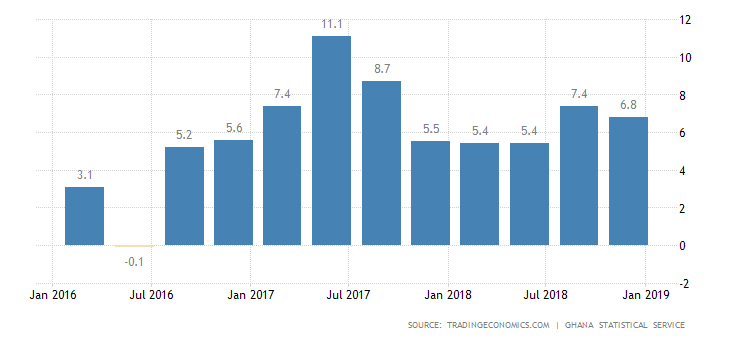Ghana ’s Economy Expands Further To 6.7%
The coast is gradually becoming clearer for Ghanaians. This is because the country’s economy has further expanded to a 6.7 percent high in the first three months of 2019. This time last year, the figure was just 5.4. This is according to Ghana ’s statistical service.

The quarter-on-quarter seasonally adjusted growth rate was 1.6 percent compared to 1.7 percent for the last three months of 2018, Professor Samuel Kobina Annim, Government Statistician said at a News Briefing.
Performance By Sectors
Non-Oil Sector
The non-oil sector grew to a 6.0 percent high during the period under review compared to 4.2 last year.
The Services Sector
Another sector to witness some growth is the services sector. Growth in that sector was 7.2 percent. The Information and communication sub-sector led the major growth, recording the highest year-on-year quarterly GDP growth rate of 37.0 percent.
The lowest growth in that sector is the Finance and Insurance sub-sector which recorded the lowest growth of 2.1 percent.
Agriculture Is The Mainstay Of Ghana’s GDP
This sector saw a growth rate of 2.2 percent for the first quarter of 2019.
The livestock sub-sector recorded the highest year-on-year growth rate of 5.5 percent, while the Forestry and logging sub-sector recorded the lowest, with a contraction of 5.8 percent.

Industry
The industry sector witnessed the highest growth rate among all the sectors. The sector saw a quarterly GDP growth rate of 8.4 percent for the first quarter of 2019.
The Mining and Quarrying sub-sector recorded the highest year-on-year quarterly GDP growth rate of 20.9 percent for the period, while the construction sub-sector recorded the lowest, with a contraction of 8.7 percent.

Producer Price Inflation
For producers in Ghana, the prices at which goods produced by them are sold witnessed some inflation.
Generally, the Producer Price Inflation fell slightly to 6.7 percent in May from 7.1 percent in April.
While the Mining and Quarrying sub-sector recorded the highest year-on-year producer price inflation rate of 15.1 percent, followed by the manufacturing sub-sector with 6.2 percent, the utility sub-sector recorded the lowest year-on-year producer inflation of prices.
Analysis of Facts
This expansion of Ghana’s economy in the first quarters of the year shows a country that is doing very well lately. It is not surprising that the sector that has witnessed the highest growth in the period under review is the mining and the quarrying sector. This sector includes gold production sub-sector.

Ghana has become the largest gold producer in Africa, toppling South Africa
This growth in the gold production sub-sector is captured recently by the World Bank in its recent data.
The data said Ghana exported 158 tonnes of gold in 2018, about 15% increase over the previous year.
This feat had made Ghana dethrone South Africa, which produced 139.3 tonnes and returned to the high volumes of the 1980s.
This Is Even As Foreign Investments Keep Pouring Into Ghana
In a recent report by the United Nations Conference on Trade and Development (UNCTAD) Ghana, which is in the midst of an oil and gas boom and saw inflows of $3 billion, making it West Africa’s leading destination for foreign investment. Italy’s Eni Group was behind Ghana’s largest greenfield investment project.
Charles Rapulu Udoh

Charles Rapulu Udoh is a Lagos-based Lawyer with special focus on Business Law, Intellectual Property Rights, Entertainment and Technology Law. He is also an award-winning writer. Working for notable organizations so far has exposed him to some of industry best practices in business, finance strategies, law, dispute resolution, and data analytics both in Nigeria and across the world.

